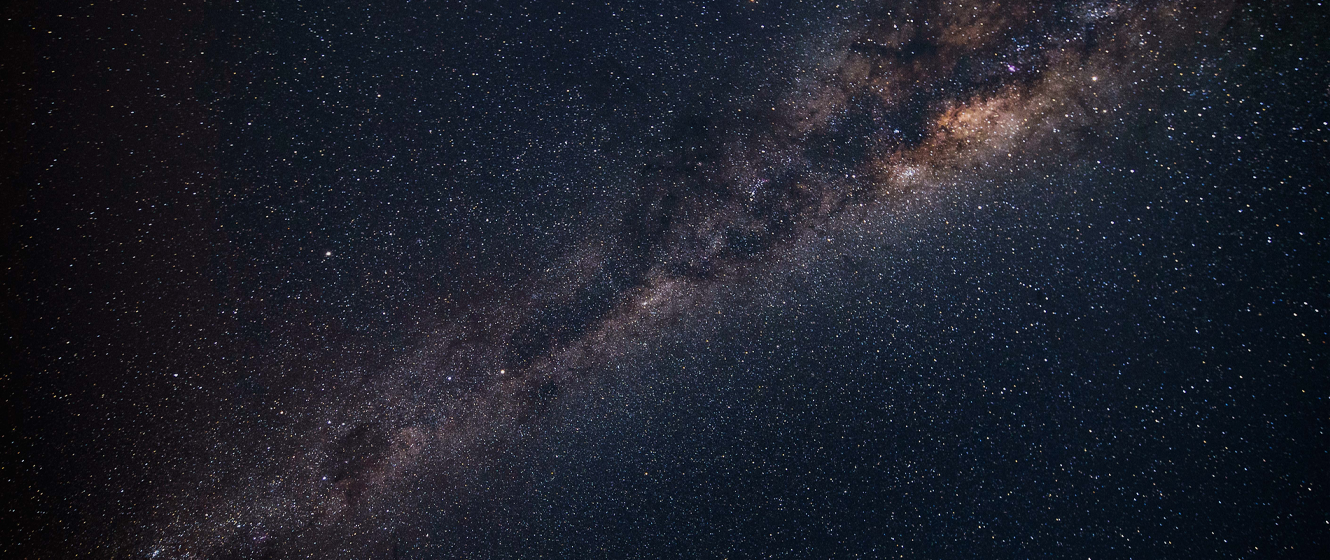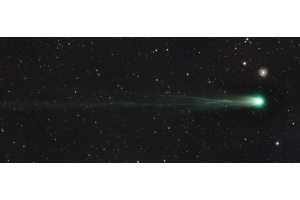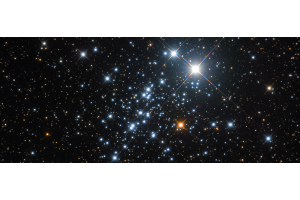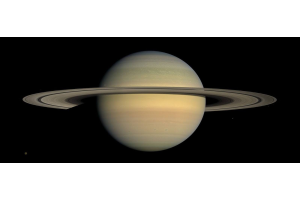
At some point or another, you’ve probably looked up and noticed a grey, misty band stretching overhead. This mistiness appears irregular, ill-defined, and quite elusive, with bright clumps in some parts and dark patches in others. It’s been known since ancient times and was named the Milky Way due to its appearance, but its true nature wasn’t known until after the invention of the telescope. So what is the Milky Way? And is it truly something special or simply our place in space?
#1 - The Milky Way Formed Nearly 14 Billion Years Ago
Our understanding of how the galaxies formed is constantly evolving as new discoveries cause new theories to be developed. The current thinking is that the Milky Way started life some 13-14 billion years ago, or about a billion years after the Big Bang. It started when a cloud of gas and dust collapsed to form a huge sphere, or halo. Over time the halo continued to gain mass until it was able to start spinning, which in turn caused the sphere to flatten to form a disc.
You can still see the remnants of the halo and some of those ancient stars today. At least 150 spherical globular clusters, each about 150 light-years in diameter, form what remains of the galactic halo. These clusters contain hundreds of thousands of old stars, with the oldest cluster thought to be about 10 billion years old, or a little more than twice the age of the Sun.

#2 - The Milky Way Way is an Average-Sized Galaxy
The nearest star to the Sun is about 4.4 light-years away, and many of the brightest stars in our sky are less than 100 light-years away. However, that distance is just a tiny fraction - one one-thousandth, to be precise - of the diameter of the Milky Way. With a width of 105,000 light-years and a stellar population of 100-400 billion stars, you’d think the Milky Way is pretty big.
On our limited scale that might be true, but the Milky Way is dwarfed by many other galaxies, with the largest being IC 1101. This galactic behemoth is thought to be 6 million light-years in diameter and could contain 100 trillion stars. You could fit sixty Milky Way galaxies across it and still have enough stars left over to make another forty!

#3 - We Live in the ‘Burbs of the Milky Way
You may already know the Milky Way is a spiral galaxy, but you might not be aware of the central bar that crosses the core. To be more specific, the Milky Way is a barred-spiral galaxy, with two main arms (Scutum-Centaurus and Perseus) extending out from either end of the bar. There are also two lesser arms (Norma and Sagittarius) that follow a similar path.
The Sun lies roughly 27,000 light-years away from the center of the galaxy, in a partially formed arm known as the Orion-Cygnus Arm, which itself lies about mid-way between the two main arms. This places us about midway between the center and the edge of the galaxy, in what might be considered the suburbs of the Milky Way.

#4 - You Can Look Towards the Center of the Milky Way on a Summer’s Night
Unfortunately, it’s not possible to see the center of the Milky Way with just your eyes - there’s just too much gas and dust in the way. However, you can confidently gaze skyward and know that you’re also looking toward the heart of our galaxy. The Milky Way appears densest in Sagittarius, the Archer, a southern constellation that’s best seen in the summer months from the northern hemisphere.
The brightest stars of Sagittarius form a pattern that resembles a teapot, with a cloud of steam apparently emanating from the spout. When you look toward this steam, you’re looking across 27,000 light-years of galactic space, filled with billions of stars and planets, toward the center of the galaxy.

#5 - There’s Black Hole at the Center of the Milky Way
You might not be able to see into the center of the Milky Way with just your eyes, but that doesn’t mean we’re unable to see what’s there. By making observations at other wavelengths (such as gamma ray and radio wavelengths) astronomers have discovered a powerful source of radio waves and named it Sagittarius A, after the constellation in which it is located.
Sagittarius A is actually made up of three components, with the strongest source of radio waves thought to be the black hole, known as Sagittarius A*. By observing the motion of a star known as S2, astronomers have determined its mass to be about 4 million solar masses. Numerous stars have since been seen to orbit Sagittarius A*, with one getting as close as Saturn is from the Sun and traveling at 8% the speed of light!

#6 - There Could be Billions of Earth-Like Worlds in the Milky Way
We don’t know for sure exactly how many stars are in the Milky Way, but a conservative estimate places the number at about 100 billion, with some estimating as many as four times that amount. Most of those stars are thought to be red dwarfs, but roughly 8% of the galactic population is thought to be made up of sun-like stars. That puts the number of sun-like stars in the Milky Way at around 8 billion or more.
Of these, it’s predicted that between 37% and 60% could have habitable planets. Taking our conservative estimate of 8 billion sun-like stars, that means there could be roughly 3 to 5 billion habitable worlds in the galaxy. Not every one is home to intelligent life of course, but using the Earth’s evolution as a model, it’s thought there are at least 36 intelligent civilizations capable of interstellar communication in the Milky Way.

#7 - The Milky Way Has Smaller, Satellite Galaxies
Although you can see the Milky Way from both the northern and southern hemispheres, observers south of the equator have two extra treats: the Large and Small Magellanic Clouds. Both are easily visible to the naked eye and have been known since ancient times, but it wasn’t until the 16th century, when explorers like Ferdinand Magellan circumnavigated the globe, that they became better known to astronomers in the north.
Both are thought to be as old as the Milky Way itself, with the Large Magellanic Cloud (LMC) spanning some 14,000 light-years and the Small Magellanic Cloud (SMC) being about half that size. Not only are they much smaller than the Milky Way, but neither one looks like their large neighbor either, with both lacking spiral arms and being classified as irregular dwarf galaxies.

#8 - The Milky Way Will Eventually Collide With its Neighbor
Our nearest large galactic neighbor is the Andromeda Galaxy. It’s a little larger than the Milky Way and about 2.6 million light-years away, making it the furthest object you can see with the naked eye. Even though several million light-years separate the two galaxies, it won’t always be that way. In fact, the Andromeda Galaxy is moving toward us at a speed of 68 miles per second (110 km/sec) and if things continue as they are, the two galaxies will eventually collide.
Fortunately, we don’t need to worry about this cosmic catastrophe just yet, as it won’t happen for another 4.5 billion years. At that time the two galaxies will merge to form a single, new galaxy, but it probably won’t resemble either of the two galaxies that existed before. Instead of a spiral galaxy, it’s more likely to form a giant elliptical galaxy. As for the solar system, the Earth will be uninhabitable by then and the Sun’s fate remains uncertain. It could be drawn toward the combined, supermassive black hole at the center and ripped apart, thrown out of the galaxy altogether, or simply pushed further away from the new galactic center.

#9 - The Milky Way is Part of the Local Group of Galaxies
The Andromeda Galaxy isn’t the Milky Way’s only neighbor. Both galaxies are a part of the Local Group, a dumbbell-shaped cluster of about 80 galaxies spanning 10 million light-years of space. On one side is the Milky Way and a multitude of much smaller dwarf galaxies, while on the other side is the Andromeda Galaxy, the Triangulum Galaxy (the other major galaxy in the group), and a second swarm of smaller galaxies.
The Local Group is itself a member of a much larger group. Known as the Virgo Supercluster, it has a diameter of about 110 million light-years and is made up of at least another 100 galaxy groups - but it doesn’t end there. The Virgo Supercluster is just one of an estimated 10 million superclusters in the observable universe. It’s located in the Pisces-Cetus Supercluster Complex, a filament measuring 150 million light-years across and a billion light-years in length.

#10 - The Milky Way is Just One of Potentially Hundreds of Billions of Galaxies
It’s hard to determine exactly how many galaxies are in the universe, but if the average number of galaxies in a group is 80, and there are an average of 100 groups in a supercluster, then there must be roughly 800 galaxies in the supercluster. If, however, there are 10 million superclusters in the observable universe, then that brings the total number of galaxies to 8 billion. While that’s a huge number in itself, it’s a long way off from a hundred billion.
However, that’s just the observable universe. It’s like being in a corner of a massive, underground cave, and while we may be able to see our nearby surroundings, it’s impossible to see what lies beyond. Not so long ago, data from the Hubble Space Telescope indicated there could be as many as two trillion galaxies in the universe, but new data from the New Horizons space probe has reduced the number to “just” hundreds of billions.
On a clear, dark night, you may be able to see around 2,500 stars in the sky. Every one of those belongs to the Milky Way galaxy, and just as each star is just one of billions in the Milky Way, the Milky Way itself is just one of billions in the universe. While this sounds as though the Milky Way is nothing special, it’s worth remembering that it’s also the city of stars in which we live - and we’ve barely managed to step outside our front door!


Questions? Contact Us!
Interested in observing or photographing the Milky Way Galaxy yourself? Not sure what gear you'll need? Send a message to our non-commissioned product advisors! Our team of telescope experts are happy to point you in the right direction.
This Article was Last Updated on 07/17/2023










